Choosing the right cooking pan is like choosing the perfect brush for an artist’s masterpiece. The types of cooking pans significantly impact the flavor, texture, and overall quality of your dishes. Therefore, learning about different types of cooking pans and their characteristics is essential for every cook.
In this comprehensive guide, we’ll walk you through the variety of cooking pans, each with its unique features. We’ll explore nonstick pans, renowned for their effortless food release, cast iron pans, known for their durability, and sleek stainless steel pans.
With our insights into each type of cooking pan, you’ll be more prepared to make informed kitchen decisions. Discover the secrets behind the perfect pan for every dish and elevate your cooking.
7 Different Types of Cooking Pans
The following are different types of cooking pans that you need to know about.
1. Non-Stick Pans
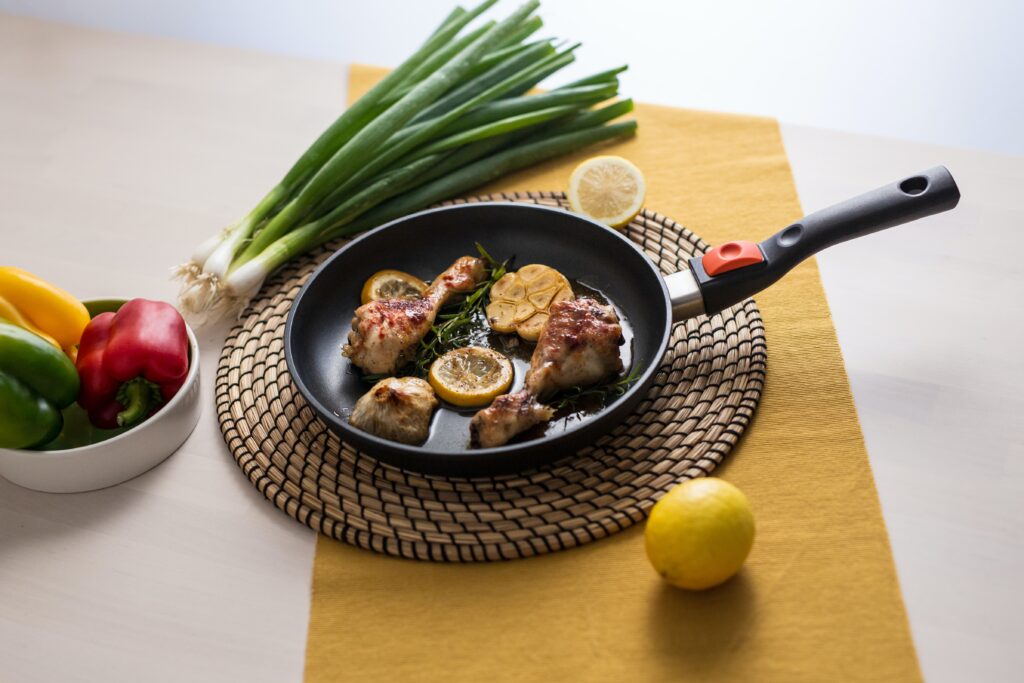
Cooking and cleaning have become more accessible and more convenient with non-stick pans. They usually have non-stick coatings made from PTFE (polytetrafluoroethylene) or ceramic. These coatings prevent food from sticking to the pan.
Advantages
The user-friendliness of non-stick pans makes them popular. Here are a few reasons why chefs and home cooks love them:
- Effortless Food Release: The most notable benefit is the ease with which food is released from the pan. The pancakes will flip perfectly, and the omelets will slide right onto your plate.
- Minimal Oil Requirement: Non-stick pans require less oil or fat for cooking, making them a healthier choice for those conscious of their dietary intake.
- Simple Cleaning: Cleanup is a breeze. A quick wipe or gentle scrub with a soft sponge typically suffices. Say goodbye to stubborn, stuck-on food residues.
Disadvantages
Although non-stick pans have numerous advantages, they also have some limitations:
- Coating Wear: Over time, the non-stick coating can break down, especially when exposed to high temperatures or abrasive utensils. At high temperatures, PTFE fumes release, which can reduce their effectiveness and even pose health risks.
- Temperature Limitations: Cooking with non-stick pans at high temperatures can damage the coating. As a result, they are not ideal for tasks such as searing and browning.
2. Stainless Steel Pans
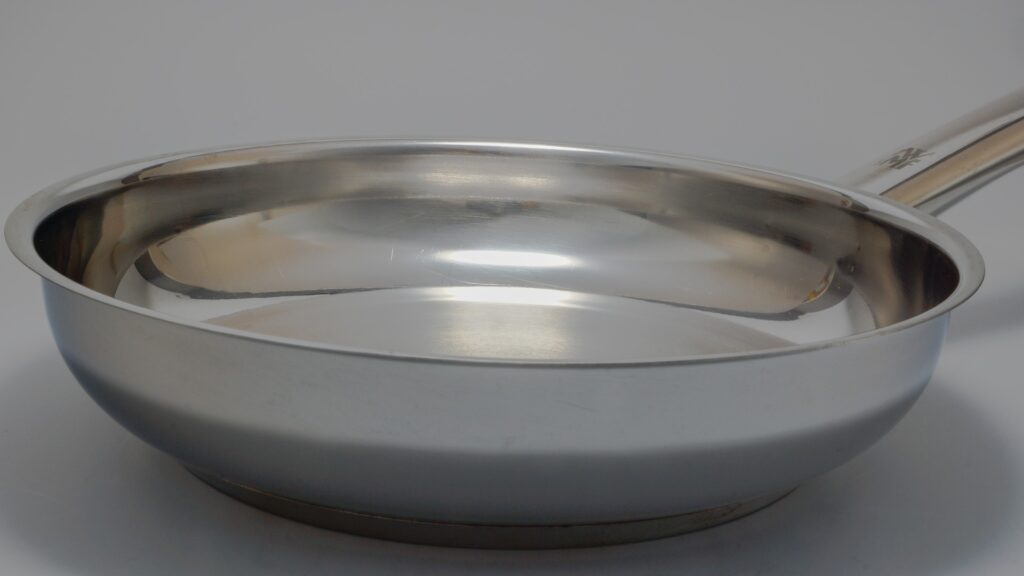
Stainless steel pans are favored for their robust construction and modern appearance. These pans are typically made from an alloy of iron, carbon, and at least 10.5% chromium, which forms a protective layer against rust and staining.
Advantages
- Durability: Stainless steel pans are exceptionally durable and resistant to damage. They are built to withstand heavy use and maintain their polished appearance over time.
- Versatility: These pans are incredibly versatile and suitable for a wide range of cooking methods. You can confidently use them for frying, sautéing, searing, and even baking.
- Low Maintenance: Stainless steel pans are relatively easy to maintain. Many are dishwasher safe, and cleaning typically involves a simple soak and scrub with a non-abrasive sponge.
Disadvantages
- Stickiness: Without proper seasoning or the use of oil or butter, stainless steel pans may have food sticking to their surface. Using the proper cooking techniques and preheating can help mitigate this issue.
- Longer Heating Time: Stainless steel pans have lower heat conductivity compared to some other materials, meaning they may require a longer preheating time.
Related: How to Season Stainless Steel Pan
3. Cast Iron Pans
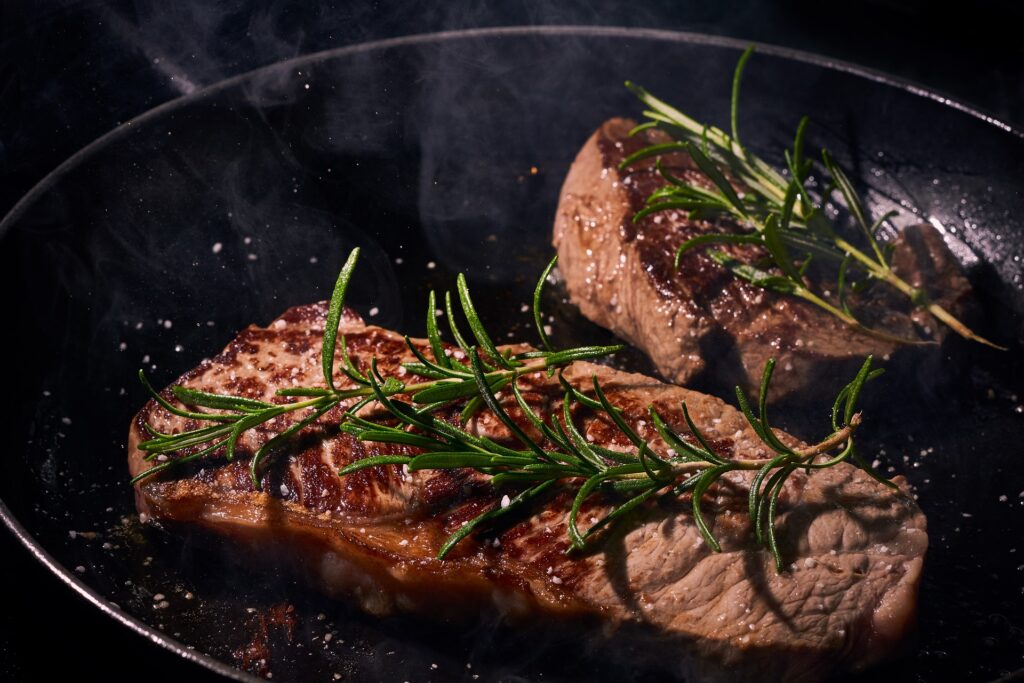
Cast iron pans are celebrated for their timeless and rugged appeal. These pans are crafted from molten iron, which is poured into molds and often finished with a layer of seasoned oil or enamel.
Advantages
- Excellent Heat Retention: Cast iron pans excel in retaining and evenly distributing heat. This property makes them ideal for slow cooking, frying, and baking.
- Versatility: These pans are incredibly versatile. They can be used on stovetops, in ovens, and even over open flames, allowing you to explore various cooking techniques.
- Non-Stick with Proper Seasoning: When seasoned correctly, cast iron pans develop natural non-stick properties, making them perfect for searing, frying, and baking with minimal sticking.
Disadvantages
- Seasoning Required: To maintain their non-stick qualities, cast iron pans require regular seasoning. This process involves applying a layer of oil and heating the pan to create a protective coating.
- Weight: The substantial weight of cast iron pans can be challenging for some users. Care should be taken when handling them, especially when they’re hot.
4. Copper Pans
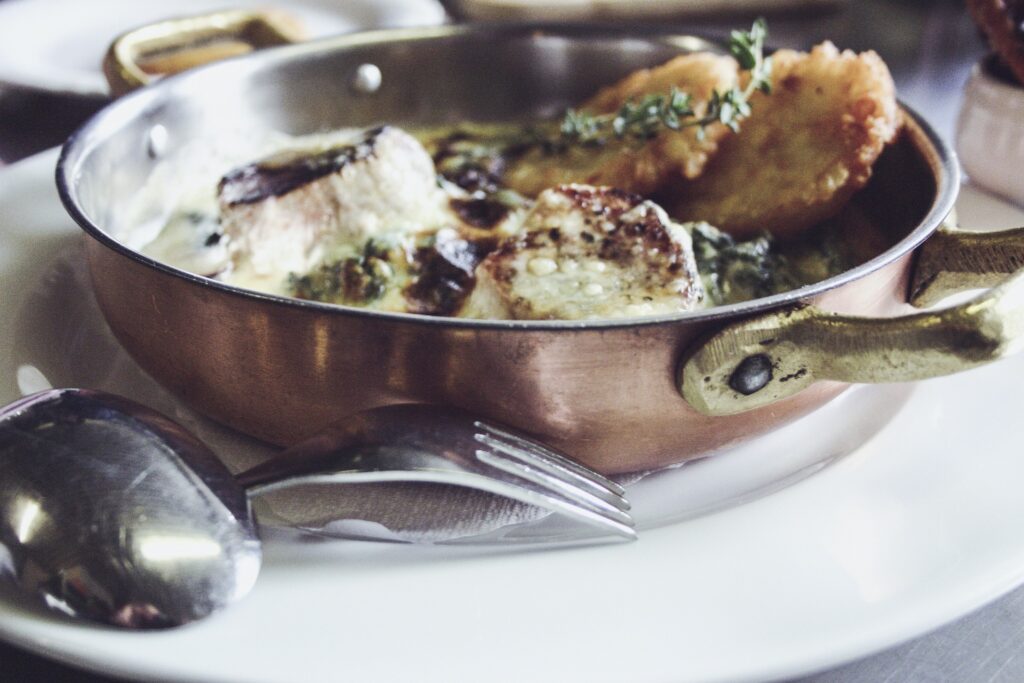
Copper pans are renowned for their exceptional heat conductivity and classic elegance. These pans are predominantly made from copper, while many feature stainless steel or tin linings.
Advantages
- Exceptional Heat Conductivity: Copper pans heat up rapidly and distribute heat evenly, which prevents hot spots and allows for precise cooking control.
- Aesthetic Appeal: Their stunning, shiny appearance can add a touch of sophistication to any kitchen. Professional chefs often use copper cookware for both its functionality and its beauty.
Disadvantages
- High Cost: Copper pans are generally more expensive compared to other types of pans due to the cost of the material and craftsmanship.
- Reactivity: Copper can react with acidic foods, potentially leading to off-flavors in certain dishes. To mitigate this, many copper pans have stainless steel or tin linings.
5. Aluminum Pans
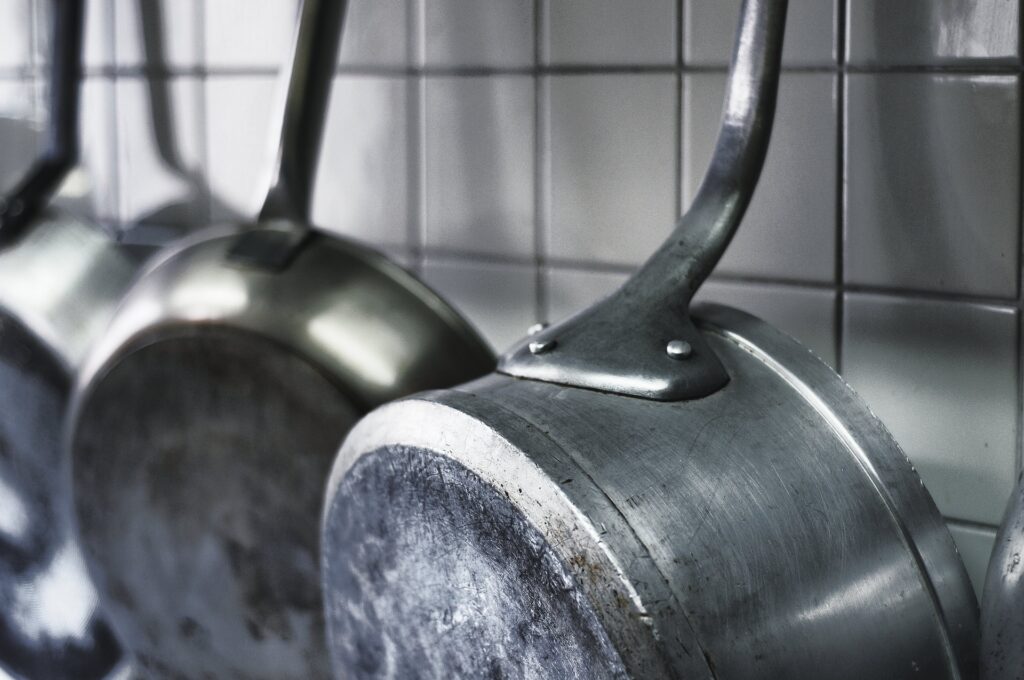
Aluminum pans are known for their affordability and excellent heat-conducting properties. These pans are typically made from aluminum or aluminum alloys.
Advantages
- Rapid Heat Distribution: Aluminum heats up quickly and evenly, making it suitable for dishes that require even cooking temperatures.
- Lightweight: They are among the lightest pans available, which makes them easy to handle.
- High-Heat Cooking: Aluminum pans can withstand high temperatures, making them ideal for tasks like searing, browning, and deep frying.
Disadvantages
- Warping: Aluminum pans may warp under high heat or if they are not handled carefully. This can lead to uneven cooking surfaces.
- Reactivity: Aluminum can react with certain acidic foods, potentially altering the taste of the dish. Some aluminum pans are coated to prevent this reactivity.
Related: What Are the Aluminum Cookware Disadvantages
6. Ceramic Pans
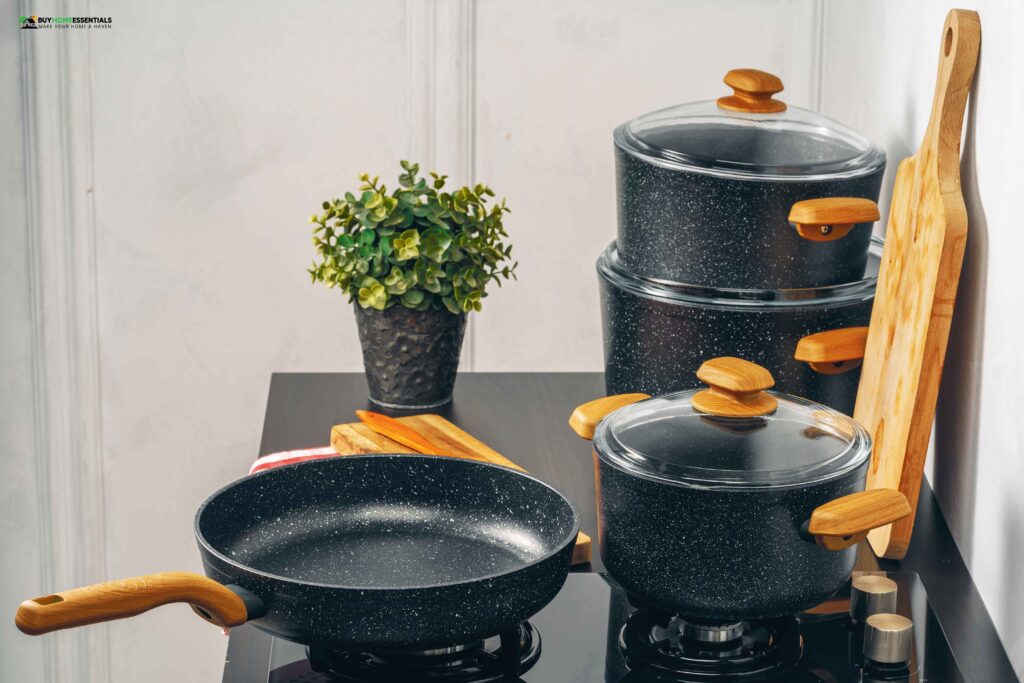
Ceramic pans are celebrated for their non-stick ceramic coating, which is typically free of PTFE (polytetrafluoroethylene) and PFOA (perfluorooctanoic acid). They come in various materials, often featuring a ceramic layer for non-stick properties.
Advantages
- Natural Non-Stick: The ceramic coating provides a non-stick surface without the use of PTFE or PFOA, making them a popular choice for health-conscious cooks.
- Easy Cleaning: These pans are easy to clean, usually requiring just a simple wipe with a soft sponge or cloth.
- Minimal Oil Requirement: The non-stick surface reduces the need for excess oil or butter, promoting healthier cooking.
Disadvantages
- Coating Wear: Over time, the ceramic coating may wear off, potentially reducing its non-stick effectiveness. Care should be taken to maintain the coating.
- High-Heat Limitations: Ceramic pans may not be suitable for high-heat cooking, such as searing or broiling, as extreme temperatures can damage the coating.
Learn More: What are the Pros and Cons of Ceramic Cookware
7. Grill Pans
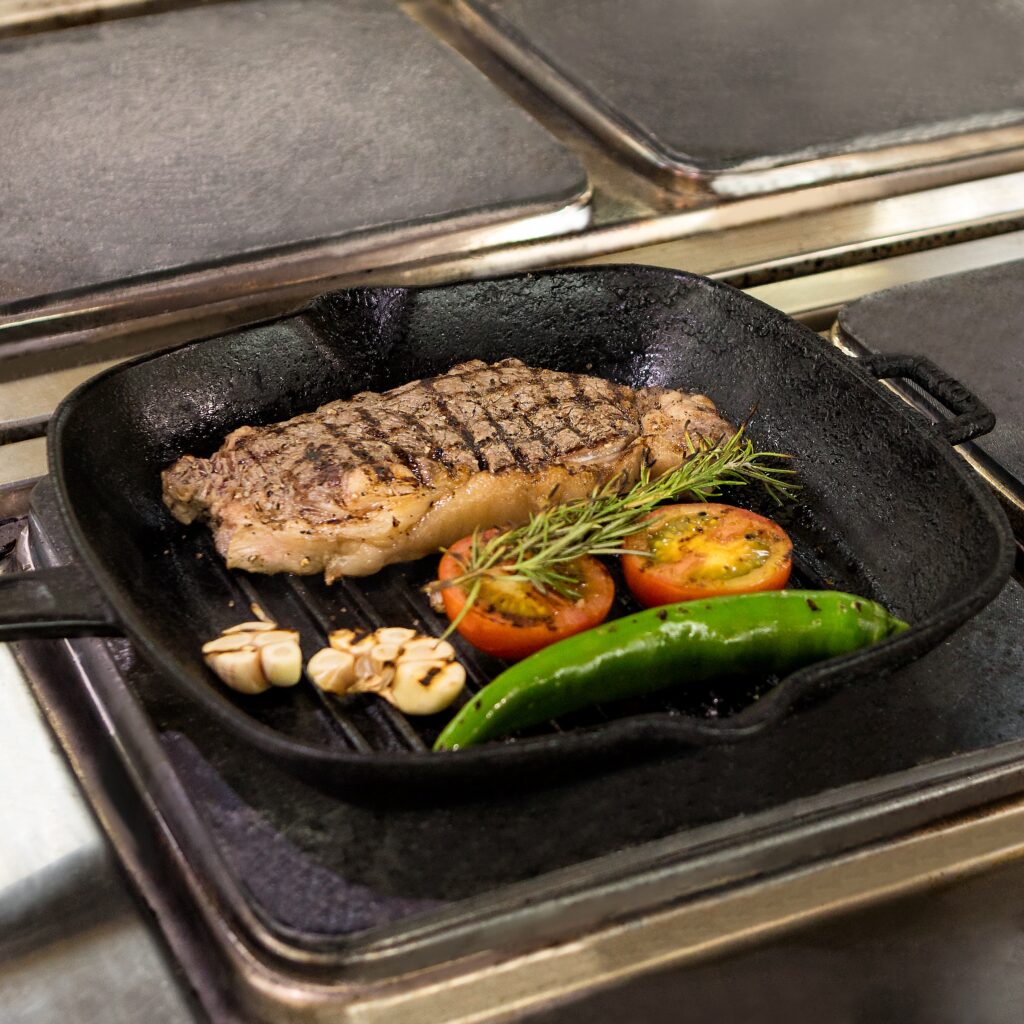
Grill pans are a unique addition to your cookware collection, designed to replicate the grill’s searing and char marks. These pans feature raised ridges that create grill-like lines on your food.
Advantages
- Grill Marks: They allow you to achieve attractive grill marks on your food without the need for an outdoor grill.
- Versatility: Grill pans can be used for grilling a wide range of foods, from vegetables and seafood to steaks and sandwiches.
Disadvantages
- Limited Uses: While excellent for grilling, they may not be as versatile as other types of pans for traditional frying, sautéing, or deep frying.
- Cleaning Challenges: Cleaning grill pans can be more challenging due to the ridges, which can trap food debris. It may require more effort and time for thorough cleaning.
The Takeaway
Cooking pans play an essential role in crafting delectable dishes in the world of culinary exploration. Each pan type we’ve examined in this guide has its personality, catering to particular cooking needs. You’ll find pans for every culinary adventure, from stainless steel to cast iron, copper to aluminum to health-conscious ceramics and grill pans.
Choosing the right pan depends on your cooking style and preferences. Knowing these pans’ strengths and weaknesses lets you make informed culinary decisions.





